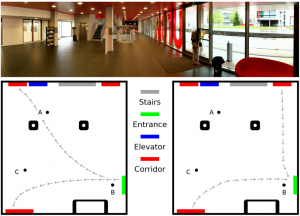![]() Tomáš Vintr, Zhi Yan, Kerem Eyisoy, Filip Kubiš, Jan Blaha, Jiří Ulrich, Chittaranjan S. Swaminathan, Sergi Molina, Tomasz P. Kucner, Martin Magnusson, Gregorz Cielniak, Jan Faigl, Tom Duckett, Achim J. Lilienthal, Tomáš Krajník
Tomáš Vintr, Zhi Yan, Kerem Eyisoy, Filip Kubiš, Jan Blaha, Jiří Ulrich, Chittaranjan S. Swaminathan, Sergi Molina, Tomasz P. Kucner, Martin Magnusson, Gregorz Cielniak, Jan Faigl, Tom Duckett, Achim J. Lilienthal, Tomáš Krajník
Natural Criteria for Comparison of Pedestrian Flow Forecasting Models
International Conference on Intelligent Robots and Systems 2020
Abstract
Models of human behaviour, such as pedestrian flows, are beneficial for safe and efficient operation of mobile robots. We present a new methodology for benchmarking of pedestrian flow models based on the afforded safety of robot navigation in human-populated environments. While previous evaluations of pedestrian flow models focused on their predictive capabilities, we assess their ability to support safe path planning and scheduling. Using real-world datasets gathered continuously over several weeks, we benchmark state-of-the art pedestrian flow models, including both time-averaged and time-sensitive models. In the evaluation, we use the learned models to plan robot trajectories and then observe the number of times when the robot gets too close to humans, using a predefined social distance threshold. The experiments show thatwhile traditional evaluation criteria based on model fidelity differ only marginally, the introduced criteria vary significantly depending on the model used, providing a natural interpretation of the expected safety of the system. For the time-averaged flow models, the number of encounters increases linearly with the percentage operating time of the robot, as might be reasonably expected. By contrast, for the time-sensitive models, the number of encounters grows sublinearly with the percentage operating time, by planning to avoid congested areas and times.
@inproceedings{vintr2020natural,
title={Natural Criteria for Comparison of Pedestrian Flow Forecasting Models},
author={Vintr, Tomas and Yan, Zhi and Eyisoy, Kerem and Kubis, Filip and Blaha, Jan and Ulrich, Jiri and Swaminathan, Chittaranjan and Molina, Sergi and Kucner, Tomasz and Magnusson, Martin and Cielniak, Gregorz and Faigl, Jan and Duckett, Tom and Lilienthal, Achim and Krajnik, Tomas},
booktitle={International Conference on Intelligent Robots and Systems},
year={2020},
organization={IEEE},
}

